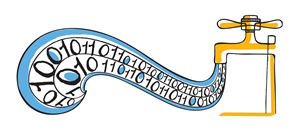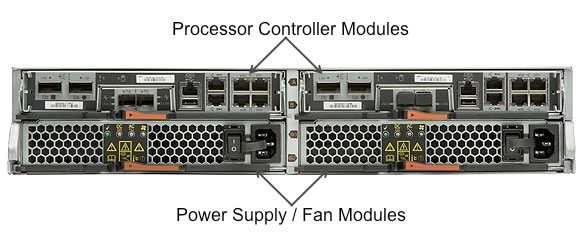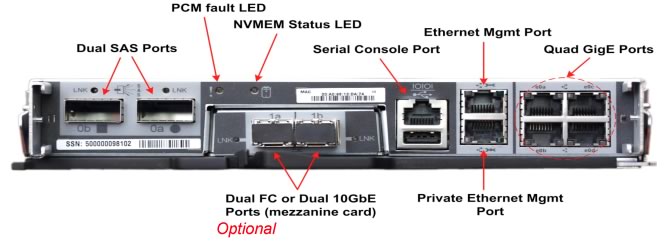




NetApp has a longstanding commitment to design storage systems that let you start right, keep it simple, and grow smart. If you’ve been reading some of the recent case studies in Tech OnTap®—including this month’s case study on Be the Match and last month’s article on Broome-Tioga—it’s clear that one of the things that administrators really like about NetApp® storage is the ability to start with a small system and then steadily evolve that system as needed over time without having to perform complicated data migrations to move from one platform to the next.
Facilitating this ability was very much on our minds when we set out to design our new entry-level storage system, the FAS2240. We also wanted to significantly enhance the reliability, availability, serviceability, and manageability (RASM) features of the new platform to bring them in line with the capabilities we offer on the FAS3200 and FAS6200 series.
In this article I’ll describe the unique design features of the FAS2240, including:
- Integration of controllers within NetApp SAS disk shelves
- I/O and performance enhancements
- New resiliency and availability features
Table 1) Key FAS2240 features.
| Feature | Benefit |
| Disk shelf conversion | If you outgrow FAS2240 capabilities, you can convert it to a disk shelf, add a new storage controller, and avoid the need for data migration. |
| High-performance I/O options | 10GbE and 8Gb FC help eliminate the possibility of network bottlenecks. |
| 2–3x performance increase | Performance to fully utilize high-performance I/O options. |
| 2U and 4U footprints | Performance-oriented 2U footprint optimized for deployment in minimum space. 4U footprint optimized for capacity. |
| Improved RASM | Same service processor (SP) management system used on NetApp midrange and high-end platforms. |
| Same microarchitecture as FAS6200 series | Enhanced compatibility across the product line. |
Good Things Come in Small Packages

With the FAS2240, we set out to up the ante. Starting in 2009, NetApp committed to the Storage Bridge Bay (SBB) standard, a choice that has allowed us to deliver the FAS2240 in a package that is smaller and denser than anything we’ve built before. At the same time, the new design makes upgrading from the FAS2240 to another platform a breeze.
We designed the controllers for the FAS2240 as SBB canisters that plug directly into our SBB-compliant DS4243 and DS2246 disk shelves. As a result, you can have a full HA storage system in the space of a single disk shelf as small as 2U in height.
Flexible ConfigurationsThe FAS2240-2 provides up to 24 small-form-factor SAS disk drives using the 2U, 19” deep chassis of the DS2246 disk shelf. This makes it the ideal candidate for extreme environments, but it’s also a great option for any situation where space is limited or maximum simplicity is desired such as in remote offices without dedicated IT staff.
The FAS2240-4 provides up to 24 SATA disk drives using the 4U chassis of the DS4243. (SAS disks are not supported in the base chassis of the FAS2240-4.) The choice of SATA makes the FAS2240-4 a more capacity-oriented option, delivering up to 72TB in only 4U of rack space.
No matter which model you choose, you can configure up to 120 additional external disks (for a total of 144 disk drives) using whatever disk shelf and disk media technology suits your needs. If you start with SAS, you can add SATA (or a mix of both) at a later time, and vice versa. Fibre Channel disk drives are also supported as well as external solid-state drives (SSDs).
Figure 1) FAS2240-2 rear view. HA configuration shown. Standalone configuration uses a single PCM.

Figure 2) FAS2240-4 rear view. HA configuration shown. Standalone configuration uses a single PCM.
Easy Upgrades: No Data Migration Required
If you outgrow your FAS2240-2 or FAS2240-4, you can convert your base chassis into a standard disk shelf by replacing the FAS2240 controller(s) (which we call processor controller modules, or PCMs) with the appropriate I/O modules (IOMs). Connect the converted shelf to the NetApp controller head of your choice, and you are back in business with no data migration required and a minimum of downtime.
Under the Hood: Processors and I/O

To deliver great performance today and prepare the FAS2240 to support Data ONTAP® well into the future, we’ve equipped it with Intel® Jasper Forest processors. This line of processors, designed specifically for embedded and storage applications, brings the same 64-bit architecture we use in the FAS6200 series—Nehalem-EP—to our entry-level platform. Choosing the same microarchitecture further enhances compatibility, allowing the two platforms to run the same microcode. Intel Hyper-Threading Technology enables multiple threads to run on each core, essentially doubling the number of independent threads that Data ONTAP can execute in parallel. With Jasper Forest on the FAS2240, NetApp now offers a full 64-bit architecture across its entire product line. Data ONTAP has supported native 64-bit hardware since 2006, making the FAS2240 another in a long line of fully 64-bit storage systems.
Optional I/O Using "Mezzanine" Cards
The new processor architecture is paired with optional mezzanine cards (one per PCM) that let you add—and take full advantage of—10 Gigabit Ethernet or 8/4/2Gbps Fibre Channel (two ports per card). You can use 10GbE to support Cluster-Mode configurations under Data ONTAP 8.1 or for high-speed client connections. The 8Gbps Fibre Channel card can be configured as either a target or an initiator, allowing you to connect to SAN hosts or Fibre Channel disk storage shelves and tape devices if desired.
Onboard I/O on each PCM includes four Gigabit Ethernet ports for LAN connections and two 6Gb wide SAS ports for connecting to internal and external SAS and SATA disks or SAS tape devices. The result is a lot of I/O in a very small package.

Figure 3) PCM showing indicator LEDs, standard ports, and optional ports on mezzanine card.
Comparison with FAS2040
Table 2 shows how the FAS2240HA stacks up to the previous-generation FAS2040.
Table 2) Comparison of the FAS2040HA and the FAS2240HA.
| FAS2040HA | FA2240HA | |
| Processor cores | 4 x 32-bit | 4 x 64-bit |
| Hyperthreading CPU | ✗ | ✓ |
| Physical memory | 8GB | 12GB |
| Onboard I/O | 4 x FC 8 x GbE 2 x 3Gb SAS | 8 x GbE 4 x 6Gb SAS |
| I/O expansion option | ✗ | ✓ |
| Optional 10GbE or 8Gb FC | ✗ | ✓ |
| Maximum spindles | 136 | 144 |
| Converts to shelf | ✗ | ✓ |
| Management | BMC | SP |
| Data ONTAP support | 7.3.2, 8.0, 8.1 | 8.1 |
In terms of performance, the FAS2240 delivers roughly 2 to 3 times the performance of the FAS2040 depending on the application.
Resiliency, Availability, Serviceability, and Manageability

On the resiliency and availability front, we’ve added a number of features to enhance the FAS2240, bringing it on par with the FAS3200 and FAS6200 series.
Service Processor
Our previous entry-level platforms had a more basic service processor than our midrange and enterprise storage platforms. We’ve updated the FAS2240 to use the same service processor design as our higher end platforms. The service processor remains operational even when the rest of a storage system is down and provides capabilities such as remote power cycle, call home notification of down system, and always-on access for troubleshooting. Additional features include:
- FRU reporting and tracking
- Advanced current/voltage and temperature sensor reporting
- Monitor LED status
- Force core dumps (replaces NMI button on controllers)
For out-of-band management of NetApp SAS disk shelves, the FAS2240 service processor also provides NetApp Alternate Control Path (ACP) technology. ACP enhances data availability by giving a storage controller the ability to reset a storage channel without having to communicate over that channel. If a channel is down or misbehaving, a quick reset can bring it back online without external intervention. ACP allows a storage system to recover from faults that might otherwise require it to reboot, and that’s a big advantage.
ACP gives you a "back door" into your disk shelves. It is completely separate from the SAS data path and provides new options for nondisruptive recovery of shelf modules, including the ability to reset or power cycle an individual I/O module or an entire domain. We designed in the ability to power cycle an entire shelf as well. ACP technology enhances the ability of Data ONTAP to automatically reset a misbehaving component in order to return it to a fully operational mode without disruption.
From an engineering standpoint, the resiliency feature I’m most excited about is the ability to go into the processor and read out its internal state even when it’s not running. The combination of core dumps and internal processor state gives us the detailed forensics to understand exactly what was happening when a problem occurred so we can correct it. We can even single step the main CPU to pinpoint failure modes. While you might never need to take advantage of these capabilities, they can help us isolate hardware failures much more quickly, reducing their potential impact. This type of capability is not common on entry-level storage.
System-Level Diagnostics
We’ve also included the same system-level diagnostics used on FAS3200 and FAS6200 to help you better identify hardware problems. You can run system-level diagnostics after one of the following events:
- Initial system installation
- Addition or replacement of hardware components
- System panic caused by an unidentified failure
- Access to a device that becomes intermittent or unavailable
- System response time that becomes sluggish and other troubleshooting has not resolved the issue
Multipath HA for Internal Disks
The FAS2240 is capable of providing MP-HA for all attached disks, both internal and external. MP-HA is the capability to provide redundant paths between storage controllers and disks for dual-controller (HA) configurations and reduces the chance of a failover occurring as the result of path failures. Having a second path to reach storage protects against a variety of possible failures, such as:
- Port failure
- Controller-to-shelf cable failure (in configuration with multiple disk shelves)
- Shelf module failure
- Dual intershelf cable failure
- Secondary path failure (in HA configurations)
While MP-HA increases overall storage resiliency, it also enables Data ONTAP to perform maintenance activities such as disk firmware upgrades nondisruptively. Performance can also improve because MP-HA provides twice the bandwidth to your storage.
Conclusion

We designed the FAS2240 to give you more flexibility than we’ve ever offered in an entry-level platform, while engineering in a level of resiliency and availability that would normally only be found in higher end, enterprise-class storage. As an added bonus, the FAS2240 includes all storage protocols at no additional charge: NFS, CIFS, Fibre Channel, and iSCSI. This is just the latest effort to build in more software value for the entry level.
Our unique design based on the Storage Bridge Bay standard allows both standalone and HA storage configurations to be housed in a single disk shelf. As a result, if your business outgrows the FAS2240, you can simply convert your base system to a disk shelf and connect it to a FAS3200 or FAS6200 series storage system without the need to migrate data. All NetApp platforms run the same Data ONTAP operating environment, and, because the FAS2240 uses the same microarchitecture as the FAS6200, compatibility between platforms is greater than ever.
Finally, we took special care to engineer the FAS2240 for non–data center environments where space is at a premium. The FAS2240-2 delivers a complete high-performance, fault-tolerant storage system with up to 24 SAS drives in a 2U chassis that’s just 19” deep.


By Steven Miller, Senior Technical Director and Platform Architect, NetApp





